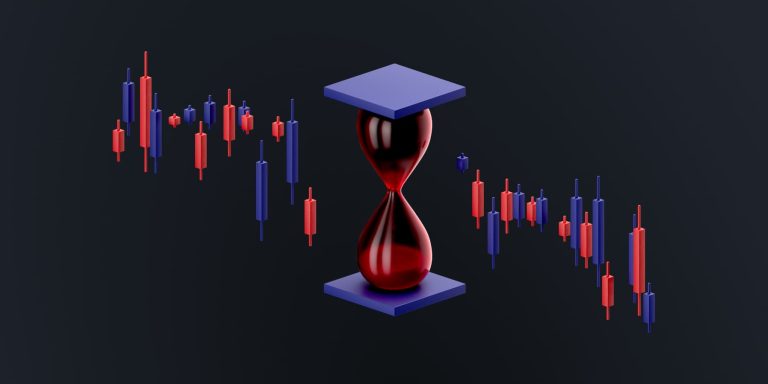
13 กลยุทธ์การซื้อขาย ETF ที่ดีที่สุด
เนื้อหา
การแนะนำ
กองทุนรวมซื้อขายแลกเปลี่ยน (ETF) คือกลุ่มหลักทรัพย์ที่ติดตามดัชนี ภาคส่วน หรือสินทรัพย์อื่นๆ และซื้อขายในตลาดหลักทรัพย์เช่นเดียวกับหุ้น ETF ช่วยให้นักลงทุนได้รับผลตอบแทนจากตลาดที่หลากหลายในรูปแบบที่คุ้มค่าและยืดหยุ่น อย่างไรก็ตาม ETF ยังสามารถซื้อขายได้อย่างต่อเนื่องเช่นเดียวกับหุ้น เพื่อทำกำไรจากการเคลื่อนไหวของราคาในระยะสั้น
แม้ว่า ETF มักใช้สำหรับการลงทุนแบบ Passive ระยะยาวผ่านการเฉลี่ยต้นทุนดอลลาร์หรือกลยุทธ์ซื้อและถือ แต่บทความนี้จะเน้นที่ 13 กลยุทธ์การซื้อขายที่มีประสิทธิภาพ เพื่อใช้ประโยชน์จากความผันผวนของราคาระหว่างวัน การซื้อขาย ETF แตกต่างจากการลงทุนตรงที่มุ่งเน้นการสร้างผลกำไรจากทั้งราคาที่ขึ้นและลงโดยใช้เลเวอเรจ วัตถุประสงค์คือเพื่อให้ผู้อ่านได้รับกลยุทธ์ทางเทคนิคที่หลากหลายและผ่านการพิสูจน์แล้วสำหรับการทำกำไรจากความผันผวนของราคา ETF
ETF คืออะไร?
กองทุนรวมซื้อขายแลกเปลี่ยน (ETF) คือเครื่องมือการลงทุนที่ถือครองสินทรัพย์ต่างๆ เช่น หุ้น พันธบัตร สินค้าโภคภัณฑ์ หรือเงินสดเทียบเท่า และซื้อขายในตลาดหลักทรัพย์เช่นเดียวกับหุ้น ETF ดำเนินงานโดยการติดตามดัชนีหรือภาคส่วนอ้างอิง โดยราคาจะเคลื่อนไหวสอดคล้องกับมูลค่าสินทรัพย์สุทธิของหลักทรัพย์อ้างอิง
ประโยชน์หลักบางประการของ ETF ได้แก่
- ต้นทุนต่ำ — ETF ส่วนใหญ่มีอัตราค่าใช้จ่ายต่ำ บางตัวต่ำกว่า 0.1% เนื่องจากมีการบริหารจัดการแบบพาสซีฟและไม่จำเป็นต้องซื้อและขายสินทรัพย์ที่ถือครองอย่างจริงจัง
- การกระจายความเสี่ยง — ช่วยให้กระจายความเสี่ยงได้ทันทีในหุ้นหรือพันธบัตรหลายตัวด้วยการซื้อขายเพียงครั้งเดียว
- ความยืดหยุ่น นักลงทุนยังสามารถได้รับการเปิดรับตลาดที่หลากหลายผ่านทาง ETF เฉพาะทางที่ติดตามภาคส่วน ประเทศ สินค้าโภคภัณฑ์ และกลุ่มเฉพาะอื่นๆ
ตัวอย่าง ETF ยอดนิยม ได้แก่
- SPDR S&P 500 ETF (SPY) ซึ่งติดตามดัชนี S&P 500 ขนาดใหญ่
- Vanguard Total Stock Market ETF ติดตามตลาดหุ้นสหรัฐฯ ทั้งหมด
- iShares MSCI Emerging Markets ETF เปิดโอกาสให้นักลงทุนได้เข้าถึงเศรษฐกิจเกิดใหม่
- และ Invesco QQQ Trust ติดตาม Nasdaq 100
นอกจากนี้ยังมี ETF พันธบัตร เช่น iShares Core US Aggregate Bond ETF และ ETF ในกลุ่มอุตสาหกรรมที่มุ่งเน้นด้านการดูแลสุขภาพ อสังหาริมทรัพย์ การเงิน และอื่นๆ อีกมากมาย ด้วย ETF กว่า 5,000 รายการทั่วโลกที่มีให้เลือกซื้อขายในตลาดหลักทรัพย์ นักลงทุนและเทรดเดอร์สามารถสร้างพอร์ตโฟลิโอหรือมุมมองตลาดได้แทบทุกรูปแบบ
การลงทุนเทียบกับการซื้อขาย ETF
การลงทุนใน ETF โดยทั่วไปหมายถึงกลยุทธ์การซื้อและถือระยะยาวที่มุ่งเน้นการสร้างรายได้และการเติบโตในระยะยาว วิธีการทั่วไป ได้แก่ การเฉลี่ยต้นทุน (Dollar-Cost Averaging) เพื่อสะสมหุ้นอย่างสม่ำเสมอ และการปรับสมดุลเป็นระยะเพื่อรักษาสัดส่วนการลงทุนในสินทรัพย์เป้าหมาย เป้าหมายหลักมักเป็นการวางแผนเกษียณอายุหรือการรักษาความมั่งคั่ง
ในทางตรงกันข้าม การซื้อขาย ETF มุ่งหวังที่จะทำกำไรจากความผันผวนของราคาในระยะสั้น ซึ่งอาจเพิ่มขึ้นหรือลดลงในช่วงหลายวัน หลายสัปดาห์ หรือระหว่างวัน วัตถุประสงค์คือการปรับจุดเข้าและจุดออกให้เหมาะสมโดยใช้เทคนิคต่างๆ เช่น การวิเคราะห์ทางเทคนิค สถานะอาจถือครองได้ตั้งแต่ไม่กี่นาทีไปจนถึงหลายเดือน ขึ้นอยู่กับกลยุทธ์และสภาวะตลาด
แม้ว่าการลงทุนเพียงแค่ซื้อหุ้น ETF แต่การซื้อขายให้ประสบความสำเร็จจำเป็นต้องใช้เลเวอเรจ เนื่องจากการเคลื่อนไหวของราคา ETF บางครั้งวัดเป็นหน่วยเซ็นต์ต่อวันหรือน้อยกว่า เลเวอเรจจึงช่วยเพิ่มผลกำไรที่อาจเกิดขึ้นได้ด้วยการเปิดสถานะซื้อขายที่สูงกว่ามูลค่าสินทรัพย์ในบัญชี
ปราศจาก เลเวอเรจ การสร้างกำไรที่มีความหมายจากการซื้อขาย ETF บ่อยครั้งถือเป็นเรื่องท้าทายเมื่อพิจารณาจากค่าคอมมิชชันและช่วงการซื้อขายรายวันที่ไม่มากนักของกองทุนต่างๆ เลเวอเรจ เพิ่มทั้งกำไรและขาดทุนตามสัดส่วน ปลดล็อกโอกาสแม้จะมีทุนน้อยแต่มีความเสี่ยงเพิ่มขึ้น
ด้วยเหตุผลเหล่านี้ CFD ซึ่งอนุญาตให้ซื้อขาย ETF แบบใช้เลเวอเรจโดยไม่ต้องเป็นเจ้าของหลักทรัพย์อ้างอิง จึงเหมาะสมกว่าการซื้อขายแบบ Spot สำหรับการนำกลยุทธ์การซื้อขาย ETF ระยะสั้นที่มีประสิทธิผลมาใช้ โดยมุ่งเน้นที่การเพิ่มผลตอบแทนที่ปรับตามความเสี่ยง
ปัจจัยสำคัญที่ต้องพิจารณาเมื่อทำการซื้อขายหรือลงทุนใน ETF
ปัจจัยสำคัญบางประการที่ควรพิจารณาเมื่อทำการซื้อขายหรือลงทุนใน ETF มีดังนี้:
ปริมาณการซื้อขาย — ตรวจสอบให้แน่ใจว่า ETF มีสภาพคล่องเพียงพอที่จะให้สามารถเข้าและออกจากตำแหน่งได้โดยไม่ทำให้ราคาเคลื่อนไหวอย่างมีนัยสำคัญ
อัตราส่วนค่าใช้จ่าย — ค่าธรรมเนียมที่ต่ำลงทำให้ผู้ลงทุนได้รับผลตอบแทนมากขึ้นในระยะยาว ดังนั้นควรเลือก ETF ที่มีต้นทุนต่อเนื่องที่เหมาะสม
ข้อผิดพลาดในการติดตาม — สำหรับ ETF ดัชนี ให้แน่ใจว่ากองทุนติดตามดัชนีอ้างอิงอย่างใกล้ชิดโดยไม่มีความแตกต่างอย่างมีนัยสำคัญในช่วงเวลาหนึ่ง
โฮลดิ้ง — ทำความเข้าใจบริษัท/สินทรัพย์ที่ประกอบเป็น ETF และให้แน่ใจว่าตรงตามวัตถุประสงค์การลงทุนและความสามารถในการรับความเสี่ยงของคุณ
ประวัติผลงาน — ตรวจสอบผลตอบแทนหลายปีภายใต้เงื่อนไขตลาดที่แตกต่างกันเพื่อวัดความสอดคล้องและความผันผวน
เลเวอเรจ — พิจารณาการใช้เลเวอเรจของ ETF ซึ่งจะเพิ่มผลตอบแทนแต่ก็เพิ่มความเสี่ยงและอาจทำให้เกิดปฏิกิริยาที่ไม่สามารถคาดเดาได้
สเปรด — ติดตามสเปรดระหว่างเสนอซื้อและเสนอขาย โดยเฉพาะอย่างยิ่งสำหรับ ETF ที่มีสภาพคล่องต่ำ เนื่องจากต้นทุนธุรกรรมเหล่านี้กินกำไรไป
การกระจายความเสี่ยง — พิจารณาถึงระดับการกระจายความเสี่ยงของ ETF ซึ่งบางกองทุนมีการมุ่งเน้นเฉพาะในภาคส่วนหรือภูมิภาคเท่านั้น
สถานะการกำกับดูแล — ตรวจสอบว่า ETF และผู้จัดทำเป็นไปตามมาตรฐานการอนุญาต การรายงาน และการปฏิบัติงานในเขตอำนาจศาลของคุณ
กลยุทธ์การลงทุน ETF
กลยุทธ์การลงทุน ETF ทั่วไป เช่น การเฉลี่ยต้นทุนแบบดอลลาร์ (Dollar-Cost Averaging) และการจัดสรรสินทรัพย์ (Asset Allocation) ได้กล่าวถึงไปแล้วก่อนหน้านี้ การเฉลี่ยต้นทุนแบบดอลลาร์ (Dollar-Cost Averaging) กำหนดให้มีการซื้อสินทรัพย์ในจำนวนที่กำหนดไว้อย่างสม่ำเสมอเพื่อสะสมหุ้นในระยะยาวที่ระดับราคาต่างๆ การจัดสรรสินทรัพย์มีวัตถุประสงค์เพื่อสร้างสมดุลความเสี่ยงโดยการกระจายการลงทุนไปตามภาคส่วน รูปแบบ และประเภทสินทรัพย์
ทั้งสองวิธีนี้เหมาะสมกว่าสำหรับนักลงทุนแบบซื้อแล้วถือ (buy-and-hold) ที่เน้นการรักษารายได้และความมั่งคั่งในระยะยาว มากกว่าการซื้อขายแบบแอคทีฟ โดยทั่วไปแล้ว การเฉลี่ยต้นทุนดอลลาร์จะดำเนินการโดยอัตโนมัติผ่านการลงทุนเป็นระยะ และการปรับสมดุลใหม่ (rebalancing) ช่วยให้มั่นใจได้ว่าความเสี่ยงที่ตั้งไว้ในตอนแรกจะยังคงอยู่ แม้มูลค่าตลาดจะผันผวนก็ตาม
รูปแบบการลงทุนแบบไม่ลงมือปฏิบัติเหล่านี้ไม่จำเป็นต้องติดตามพฤติกรรมราคาระยะสั้นอย่างใกล้ชิด หรือจับจังหวะเวลาเข้าและออกตลาดอย่างใกล้ชิด กลยุทธ์เหล่านี้จัดอยู่ในประเภทการลงทุนมากกว่าการเทรดแบบแอคทีฟ เนื่องจากมีจุดประสงค์เพื่อลงทุนในการเติบโตระยะยาวโดยมีการตัดสินใจต่อเนื่องน้อยที่สุด สำหรับเทรดเดอร์ที่ต้องการใช้ประโยชน์จากรูปแบบราคาที่เปลี่ยนแปลงไปในแต่ละวัน รายสัปดาห์ หรือรายเดือน กลยุทธ์ทางเลือกอื่นๆ จะได้รับการปรับให้เหมาะสมมากกว่า
You may also like

วิธีลงทุนใน ETF
ขั้นตอนสำคัญในการลงทุนใน ETF มีดังนี้:
เปิดบัญชีนายหน้า — เลือกโบรกเกอร์ ซึ่งโดยทั่วไปจะเป็นโบรกเกอร์ออนไลน์ สำหรับการซื้อขาย ETF มองหาค่าธรรมเนียมการซื้อขายและค่าคอมมิชชันที่ต่ำ
กำหนดเป้าหมายการลงทุนและระยะเวลาของคุณ — พิจารณาว่าคุณต้องการรายได้ การเติบโต หรือความสมดุล ตัดสินใจว่าคุณสามารถลงทุนได้นานแค่ไหน หลายปีหรือหลายทศวรรษก็เหมาะสมที่จะลงทุนใน ETF
เลือก ETF ของคุณ — ศึกษา ETF ชั้นนำตามหมวดหมู่ เช่น ดัชนี ภูมิภาค ภาคส่วน หรือประเภทสินทรัพย์ ประเมินปัจจัยต่างๆ เช่น ต้นทุน การถือครอง และประวัติการลงทุน
กำหนดการจัดสรรสินทรัพย์ของคุณ — กระจายการลงทุนของคุณในสินทรัพย์ประเภทต่างๆ เช่น หุ้นและพันธบัตร ตามระดับความเสี่ยงของคุณ
ค่าเฉลี่ยต้นทุนดอลลาร์ — สนับสนุนเงินจำนวนหนึ่งอย่างสม่ำเสมอเพื่อซื้อหุ้น ETF เพิ่มเมื่อราคาต่ำลง และน้อยลงเมื่อราคาสูงขึ้น
ทำให้การซื้อของคุณเป็นระบบอัตโนมัติ — ตั้งค่าการหักเงินอัตโนมัติจากธนาคารของคุณหากเป็นไปได้เพื่อรักษาวินัยและลดค่าธรรมเนียมธุรกรรม
ปรับสมดุลใหม่เป็นระยะ — ปรับการจัดสรรของคุณกลับไปสู่เป้าหมายเริ่มต้น เนื่องจาก ETF บางตัวมีผลงานดีกว่าตัวอื่นๆ เมื่อเวลาผ่านไป
ตรวจสอบพอร์ตโฟลิโอของคุณและทำการเปลี่ยนแปลงตามความจำเป็น เปลี่ยน ETF ที่ทำผลงานต่ำกว่ามาตรฐาน ปรับเปลี่ยนการจัดสรรตามความต้องการที่เปลี่ยนแปลง และตรวจสอบต้นทุนและการกระจายความเสี่ยง
พิจารณาเงินปันผลของคุณ — ETF หลายแห่งจ่ายเงินปันผล ดังนั้นคุณต้องเข้าใจว่าคุณต้องการเงินสดหรือเงินปันผลมาลงทุนซ้ำ
รักษาทัศนคติในระยะยาว — เว้นแต่สถานการณ์จะเปลี่ยนแปลง ให้ซื้อและถือ ETF ไว้เป็นเวลาหลายปีเพื่อให้ได้รับประโยชน์สูงสุดจากผลตอบแทนทบต้นในระยะยาว
เหตุใด CFD จึงดีที่สุดสำหรับการซื้อขาย ETF
สัญญาซื้อขายส่วนต่าง (CFD) คือสัญญาซื้อขายล่วงหน้าแบบเลเวอเรจที่อนุญาตให้เทรดเดอร์เก็งกำไรจากราคาที่เพิ่มขึ้นหรือลดลงโดยไม่ต้องถือครองสินทรัพย์อ้างอิงจริง สัญญา CFD จะทำให้เทรดเดอร์ทำข้อตกลงแลกเปลี่ยนส่วนต่างระหว่างราคาเปิดและราคาปิดของสัญญา CFD คูณด้วยจำนวนหน่วยที่ระบุไว้ในสัญญา
ที่สำคัญ CFD มอบความเสี่ยงแบบเลเวอเรจ ซึ่งหมายความว่าเทรดเดอร์สามารถเปิดสถานะที่มีมูลค่าหลายเท่าของเงินลงทุนเริ่มต้น เลเวอเรจช่วยเพิ่มทั้งกำไรและขาดทุนตามสัดส่วนของเลเวอเรจที่ใช้ ดังนั้นเทรดเดอร์จึงต้องพิจารณาเงินทุนที่ยอมรับได้และกลยุทธ์ที่ตนเองมี
เมื่อซื้อขาย ETF ผ่าน CFD เทรดเดอร์สามารถควบคุมมูลค่าหุ้นหรือมูลค่าดอลลาร์ของ ETF จำนวนมากได้ ในขณะที่ฝากเงินเพียงบางส่วนเป็นหลักประกันเริ่มต้น ตัวอย่างเช่น ด้วยเลเวอเรจ 2:1 เทรดเดอร์สามารถรักษาสถานะ ETF มูลค่า 10,000 ดอลลาร์สหรัฐฯ ไว้ได้ด้วยการฝากเงินเพียง 5,000 ดอลลาร์สหรัฐฯ เข้าบัญชี วิธีนี้ช่วยให้สามารถสร้างผลกำไรที่คุ้มค่าจากการเคลื่อนไหวของราคาเพียงเล็กน้อย ซึ่งอาจเป็นไปไม่ได้หากซื้อขาย ETF โดยตรง
นอกจากนี้ ซึ่งแตกต่างจากการถือหุ้น ETF จริง ๆ สถานะ CFD ไม่ต้องเสียค่าอากรแสตมป์ ภาษี หรือการปรับเงินปันผลจากการถือครองหุ้นอ้างอิงจริง ๆ ไม่มีข้อจำกัดในการขายชอร์ต ETF ซึ่งทำให้มีมุมมองที่หลากหลายทั้งในแง่บวกและแง่ลบ
สัญญาออปชันและสัญญาซื้อขายล่วงหน้าให้ผลตอบแทนแบบเลเวอเรจเช่นกัน แต่เกี่ยวข้องกับวันหมดอายุ กลไกการกำหนดราคาที่เฉพาะเจาะจง และความเสี่ยงจากการส่งมอบจริง ซึ่งทำให้เหมาะสำหรับการลงทุนระยะยาวมากกว่าการซื้อขาย ETF ระยะสั้นที่คล่องตัว CFD ช่วยขจัดอุปสรรคเหล่านี้ เพื่อช่วยให้สามารถวิเคราะห์ทางเทคนิคและปรับเปลี่ยนสถานะการลงทุนอย่างต่อเนื่องตามการเคลื่อนไหวของราคา
13 กลยุทธ์การซื้อขาย ETF ที่ดีที่สุด
การติดตามแนวโน้ม
กลยุทธ์การซื้อขาย ETF แบบ Trend Following เป็นกลยุทธ์การซื้อขายที่เรียบง่ายแต่มีประสิทธิภาพ ซึ่งมุ่งเน้นการทำกำไรจากแนวโน้มราคาที่โดดเด่นในตลาด กลยุทธ์นี้เน้นการเปิดสถานะซื้อ (Long Position) ใน ETF ที่กำลังมีแนวโน้มขาขึ้น และเปิดสถานะขาย (Short Position) ใน ETF ที่กำลังมีแนวโน้มขาลง เทรดเดอร์จะวิเคราะห์ตัวบ่งชี้ต่างๆ เช่น ค่าเฉลี่ยเคลื่อนที่ เพื่อระบุการเปลี่ยนแปลงจากแนวโน้มระยะสั้นไปสู่ระยะกลาง และซื้อขายในทิศทางของโมเมนตัมในกรอบเวลาที่สูงขึ้น
แนวทางที่นิยมใช้กันคือการใช้ระบบครอสโอเวอร์ที่มีเส้นค่าเฉลี่ยเคลื่อนที่ 50 วันและ 200 วัน โดยเปิดสถานะซื้อ (Long) เมื่อราคาตัดผ่านเส้นค่าเฉลี่ยเคลื่อนที่ 200 วันในระยะเวลา 50 วัน และปิดสถานะ หรือเปิดสถานะขาย (Short) เมื่อราคาตัดผ่านเส้นแนวโน้มขาลง ด้วยเลเวอเรจ CFD เทรดเดอร์สามารถใช้ประโยชน์จากการเคลื่อนไหวแนวโน้มแม้เพียงเล็กน้อยในช่วงหลายสัปดาห์หรือหลายเดือน ความเสี่ยงจะถูกจัดการผ่านระบบตัดขาดทุนอัตโนมัติ หากแนวโน้มกลับตัวตรงข้ามกับสถานะเปิด
การติดตามแนวโน้ม (Trend Following) เหมาะอย่างยิ่งสำหรับการซื้อขาย CFD เนื่องจากมุ่งเน้นการลงทุนในระยะยาว เลเวอเรจช่วยเพิ่มผลกำไรจากวันที่มีแนวโน้มสำคัญ ขณะเดียวกันก็ช่วยลดสถานะการถือครองบางส่วนเมื่อเกิดการย่อตัวของราคาเพื่อทำกำไร เทรดเดอร์สามารถศึกษาข้อมูลภาคส่วนและตลาดโลกเพื่อระบุแนวโน้มที่กำลังพัฒนาใน ETF ที่หลากหลาย แม้ว่าความผันผวนอาจเกิดขึ้นในช่วงที่แนวโน้มหยุดชะงัก แต่การคงขนาดสถานะไว้เพื่อยอมรับความเสี่ยงเป็นสิ่งสำคัญ
การซื้อขายแบบสวิง
การซื้อขายแบบสวิงเทรดมีเป้าหมายเพื่อทำกำไรจากความผันผวนของราคาในระยะกลางภายในแนวโน้มที่กำลังดำเนินอยู่ โดยทั่วไปจะถือสถานะไว้ตั้งแต่ไม่กี่วันไปจนถึงหลายสัปดาห์ ตัวบ่งชี้ทางเทคนิคช่วยระบุระดับที่ ETF แกว่งตัวไปมาระหว่างแนวรับและแนวต้านซ้ำๆ ซึ่งเป็นสัญญาณบ่งชี้จุดเปลี่ยนที่อาจเกิดขึ้น
การซื้อขายแบบสวิงเทรดทั่วไปจะมองหาการดีดตัวของ Bollinger Band ด้านบนและด้านล่าง ประกอบกับการตัดกันของค่าเฉลี่ยเคลื่อนที่ การเข้าซื้ออาจอยู่ที่การปิดนอกกรอบเส้นค่าเฉลี่ย พร้อมกับการตัดกันของ MACD ที่เป็นขาขึ้น ขณะเดียวกันก็ทำกำไรบางส่วนเมื่อกลับเข้ากรอบเส้นค่าเฉลี่ย และขายออกทั้งหมดเมื่อราคาทะลุกรอบเส้นค่าเฉลี่ยเคลื่อนที่
CFD อำนวยความสะดวกในการเทรดแบบสวิงเทรด โดยอนุญาตให้ทำกำไรบางส่วนได้โดยไม่ต้องปิดสถานะเต็มจำนวน ข้อกำหนดมาร์จิ้นที่ต่ำยังหมายความว่าเทรดเดอร์สามารถถือครองตัวเลือกสวิงเทรดหลายรายการพร้อมกันได้ การจัดการความเสี่ยง เกี่ยวข้องกับการหยุดตามที่เกิดขึ้นพร้อมกับการซื้อขาย เพื่อรักษาผลกำไรในขณะที่ให้ผู้ชนะเกิดขึ้นได้อย่างเต็มที่
การซื้อขายรายวัน
การซื้อขายรายวัน มุ่งหวังที่จะได้รับประโยชน์จากความผันผวนของราคาระหว่างวันในระยะสั้น ผ่านการถือครองสถานะภายในเวลาเพียงไม่กี่นาทีหรือไม่กี่ชั่วโมง แม้ว่าจะจำเป็นต้องมีการติดตามอย่างใกล้ชิด แต่ก็เป็นประโยชน์ต่อเทรดเดอร์ขั้นสูงที่วิเคราะห์โซนอุปทานและอุปสงค์ที่เกิดขึ้นเป็นประจำ
ด้วยเลเวอเรจ CFD เดย์เทรดเดอร์สามารถใช้ประโยชน์จากการเคลื่อนไหวของ ETF เพียงเล็กน้อยที่สูงกว่าค่าคอมมิชชั่นได้ วิธีการทั่วไปคือการสแกนหาระดับการฟื้นตัวจากจุดกลับตัวรายวันและรายชั่วโมง และใช้จุดทะลุเพื่อคาดการณ์การฟื้นตัวของราคา จุดคุ้มทุนช่วยให้สามารถรักษากำไรไว้ได้ในขณะที่ทดสอบเป้าหมาย
เหตุการณ์ข่าวและการประกาศเศรษฐกิจต่างๆ ก่อให้เกิดความผันผวนของ ETF ที่เชื่อถือได้ในบางช่วงเวลา เทรดเดอร์มักติดตามข้อมูลทางการเงินก่อนผลประกอบการของธนาคาร หรือติดตามผลประกอบการของเทคโนโลยีล่วงหน้าเพื่อคาดการณ์ปฏิกิริยาที่เกิดขึ้น การตั้งค่า Scalping อาจเข้าสู่ช่วงราคาที่ทะลุกรอบ หรือปรับตัวลงสู่เส้นค่าเฉลี่ยเคลื่อนที่ CFD เหมาะอย่างยิ่งเนื่องจากเดย์เทรดเดอร์สามารถเข้าถึงการเคลื่อนไหวที่เกิดขึ้นชั่วครู่เหล่านี้ได้
การถลกหนังหัว
Scalping คือเทคนิคการเทรดแบบเดย์เทรดระยะสั้นพิเศษที่มุ่งทำกำไรจากความผันผวนของราคา ETF เพียงเล็กน้อยที่ต่ำกว่า 1% เทคนิคนี้ต้องการการเข้าและออกอย่างรวดเร็ว โดยมักจะถือสถานะเพียงไม่กี่นาทีก่อนทำกำไร ด้วยการติดตามความถี่สูงและการดำเนินการคำสั่งซื้อขายที่รวดเร็ว นักเทรดแบบ Scalping จึงสามารถใช้ประโยชน์จากความไม่สมดุลของราคาขายระยะสั้นได้
การตั้งค่า Scalping จะช่วยตรวจจับการเปลี่ยนแปลงโมเมนตัมของคำสั่งซื้อขาย ETF โดยใช้กราฟ Tick ภายในเวลาไม่ถึง 5 นาที สัญญาณต่างๆ รวมถึงการทะลุกรอบแคบๆ 1-2 จุด หรือการดีดตัวกลับจากค่าเฉลี่ยเคลื่อนที่หรือจุดหมุน เทรดเดอร์ใช้เลเวอเรจสูง เช่น 5:1 เพื่อให้การเคลื่อนไหวเล็กๆ น้อยๆ เหล่านี้คุ้มค่าและทำกำไร
เวลาเป็นสิ่งสำคัญยิ่ง นักเก็งกำไรมักจะติดตาม ETF หลายตัวพร้อมกัน ทำกำไรได้อย่างรวดเร็วจนได้กำไรตามเป้าหมาย 5-10 ติ๊ก หรือขาดทุนเท่าทุน การควบคุมความเสี่ยงเกี่ยวข้องกับการกำหนดขนาดสถานะการลงทุนเพื่อให้ยอมรับการขาดทุนรายวันได้สูงสุด ข่าวสารพื้นฐานไม่สำคัญ เป็นเพียงข้อมูลทางเทคนิคและเชิงปริมาณเท่านั้น
CFD เหมาะอย่างยิ่งเนื่องจากไม่สร้างภาระให้กับนักลงทุนเก็งกำไรด้วยค่าคอมมิชชัน และการถอนเงินก็รวดเร็ว กำไรจากเลเวอเรจมีมากกว่าต้นทุน ทำให้ ETF ระยะสั้นมีความผันผวนสูงด้วยการเดิมพันเพียงเล็กน้อย วินัยและประสบการณ์เป็นสิ่งจำเป็นอย่างยิ่งในการรับมือกับการขาดทุนระยะสั้นที่หลีกเลี่ยงไม่ได้
การป้องกันความเสี่ยง
การป้องกันความเสี่ยงช่วยปกป้องพอร์ตโฟลิโอ ETF โดยใช้การซื้อขาย CFD ในทางตรงกันข้าม การป้องกันความเสี่ยงเป็นสิ่งสำคัญสำหรับเทรดเดอร์ที่คาดการณ์การเปลี่ยนแปลงของตลาดอย่างรวดเร็วหรือความผันผวนที่พุ่งสูงขึ้น ซึ่งอาจส่งผลกระทบต่อสถานะการลงทุน การป้องกันความเสี่ยงจะช่วยชดเชยความเสี่ยงมากกว่าการเก็งกำไรแบบมีทิศทาง
การซื้อขายคู่สกุลเงินป้องกันความเสี่ยง ETF หนึ่งเทียบกับอีกสกุลเงินหนึ่ง แต่กลับมีปฏิกิริยาตรงกันข้าม ผู้ที่ถือครองหุ้น S&P 500 ระยะยาวอาจขายชอร์ต ETF ของ Nasdaq หากคาดการณ์ว่าฟองสบู่เทคโนโลยีจะฟื้นตัว ผู้ที่ถือครองหุ้นสินค้าโภคภัณฑ์ระยะสั้นอาจป้องกันความเสี่ยงจากหุ้นพลังงานระยะยาวเนื่องจากความกังวลเกี่ยวกับอุปทาน ผู้ที่ถือครองทองคำอาจขายชอร์ต ETF ของกระทรวงการคลัง เนื่องจากหุ้นเหล่านี้มักมีทิศทางที่แตกต่างกัน
ฟิวเจอร์สยังป้องกันความเสี่ยงพอร์ตการลงทุน เช่น การขายชอร์ต CFD/ES เทียบกับการถือครองหุ้นขนาดใหญ่ที่มีแนวโน้มขาลง ส่วน ETF ที่มีเลเวอเรจแบบหมีจะขายทำกำไรสวนทางกับหุ้นที่มีชื่อเดียวที่มีแนวโน้มขาขึ้น หากคาดการณ์ว่าราคาจะปรับตัวลดลง การซื้อขายแบบ Outright Volatility โดยใช้ CFD บน VXX จะสวนทางกับระดับ VIX
การเก็งกำไร
การเก็งกำไรแบบ Arbitrage ใช้ประโยชน์จากความผิดปกติของราคา ETF ภายในและระหว่างตลาดหลักทรัพย์ที่แสวงหาผลกำไรที่ปราศจากความเสี่ยง การเก็งกำไรแบบ Intra-arbitrage เกี่ยวข้องกับ ผู้ให้บริการสภาพคล่อง ทำกำไรจากส่วนต่างราคาระหว่างการสร้างและขายคืนแบบอัตโนมัติ การลงทุนแบบเก็งกำไรระหว่างตลาดมุ่งเน้นไปที่การเบี่ยงเบนอย่างต่อเนื่องในรายชื่อ ETF ที่เหมือนกันทั่วภูมิภาค
เทรดเดอร์มักใช้เครื่องมือ arbitrage ของ ETF เพื่อมองหาโอกาสในการซื้อขายข้ามตลาด โดยเข้าสู่ตลาดที่มีราคาต่ำและขายชอร์ตในตลาดที่มีราคาแพงกว่า CFD ที่มีเลเวอเรจช่วยเพิ่มผลกำไร เนื่องจากราคาที่บรรจบกันช่วยขจัดความเสี่ยงที่จะเกิดขึ้น ยกตัวอย่างเช่น ETF ของ iShares MSCI Emerging Markets ที่จดทะเบียนในยุโรปและสหรัฐอเมริกา บางครั้งมีความแตกต่างกัน ทำให้สามารถซื้อขายแบบ arbitrage ได้โดยปราศจากความเสี่ยง
การซื้อขายข่าว
การซื้อขายข่าวจะพิจารณาสถานะในการประกาศต่างๆ ที่จะส่งผลต่อ ETF เช่น รายงานเศรษฐกิจ การประชุมธนาคารกลาง และผลประกอบการของบริษัท โดยจะพิจารณาจากปฏิกิริยาที่คาดการณ์ไว้ การเข้าซื้อขายล่วงหน้า และการออกอย่างรวดเร็วเมื่อมีการประกาศ
เทรดเดอร์ติดตามข่าวสารธุรกิจอย่างต่อเนื่องเพื่อระบุเหตุการณ์ที่คาดว่าจะส่งผลต่อตลาด พวกเขาวิเคราะห์ปฏิกิริยาก่อนหน้า แนวโน้มในวงกว้าง และศึกษาการคาดการณ์ของนักเศรษฐศาสตร์เพื่อประเมินแนวโน้มราคาที่อาจเกิดขึ้น CFD ช่วยให้สามารถเข้าซื้อขายแบบ Scalping ได้อย่างรวดเร็ว ทั้งในช่วงที่มีข่าวและช่วงที่ไม่มีข่าว
ยกตัวอย่างเช่น การจ้างงานนอกภาคเกษตรกรรม (non-farm payrolls) เรียกว่า SPY และ ETF ในกลุ่มอุตสาหกรรมเคลื่อนที่ ซึ่งมีระดับซื้อมากเกินไป/ขายมากเกินไปที่ชัดเจน เทรดเดอร์อาจเข้าทำการปรับฐานล่วงหน้าสองสามชั่วโมง โดยลดระดับหยุดการซื้อขายเพื่อรอช่วงเวลา 2 นาทีที่ผันผวน เลเวอเรจช่วยเพิ่มกำไร เนื่องจากความผันผวนจะลดลงทันทีหลังจากประกาศ หากพิสูจน์ได้อย่างแม่นยำ การควบคุมความเสี่ยงอย่างมีวินัยจะช่วยป้องกันเหตุการณ์ไม่คาดฝัน
การเดิมพันตามแนวโน้มตามฤดูกาล
รูปแบบตามฤดูกาลมีอิทธิพลต่อ ETF บางตัว ทำให้เกิดการคาดการณ์แนวโน้มราคา สินค้าโภคภัณฑ์อย่างทองคำมักจะปรับตัวสูงขึ้นในเดือนตุลาคม เนื่องจากความต้องการที่เพิ่มขึ้นในเอเชียก่อนเทศกาลต่างๆ การลดลงของสต็อกก๊าซธรรมชาติและน้ำมันในช่วงฤดูหนาวอันสั้นเนื่องจากความต้องการที่ลดลงก็เกิดขึ้นเป็นประจำเช่นกัน
เทรดเดอร์ศึกษาแนวโน้มตามฤดูกาลในอดีต จัดโครงสร้างการเข้าซื้อและเป้าหมาย สำหรับทองคำ การซื้อ ETF ทองคำแท่งในเดือนกันยายนและตั้งเป้าความแข็งแกร่งในเดือนตุลาคมได้ผลเมื่อเร็วๆ นี้ การขายชอร์ตหุ้นกลุ่มพลังงานตั้งแต่เดือนพฤศจิกายนถึงมกราคมได้ผลดีเมื่อความต้องการลดลง
แม้ว่าโดยเฉลี่ยแล้วจะคาดเดาได้ แต่แนวโน้มทั้งหมดก็มักจะล้มเหลวโดยบังเอิญเป็นครั้งคราว การเดิมพันแนวโน้มยังคงมีความเสี่ยง และจำเป็นต้องอาศัยเทรดเดอร์ที่มีประสบการณ์ที่พร้อมยอมรับการขาดทุนหลายปีเพื่อให้ผู้อื่นได้รับกำไร การกระจายพอร์ตการลงทุนช่วยลดความเสี่ยงและรับกำไรบางส่วนเพื่อป้องกันความเสี่ยงจากความประหลาดใจ
การซื้อขายรอบเหตุการณ์สำคัญ
การคาดการณ์ปฏิกิริยาของ ETF ต่อเหตุการณ์ที่กำหนดไว้ ช่วยให้เทรดเดอร์สามารถวางตำแหน่งล่วงหน้าได้อย่างมีประสิทธิภาพท่ามกลางความผันผวนของตัวเร่งปฏิกิริยา ผลประกอบการรายไตรมาสสร้างความผันผวนอย่างมากต่อบางภาคส่วน โดยมักทำให้การเคลื่อนไหวที่ผันผวนในแต่ละวันสั้นลงเหลือเพียงไม่กี่ชั่วโมง
การศึกษาผลกระทบต่อรายได้ก่อนหน้าและห่วงโซ่อุปทานออปชันเผยให้เห็นแนวโน้มที่เป็นไปได้หลังการพิมพ์ เทรดเดอร์เข้าสู่ ETF ที่ถือครองก่อนตลาดเปิด โดยมองหาการทะลุขึ้นอย่างรวดเร็วหรือการร่วงลงอย่างรวดเร็ว ซึ่งเอื้ออำนวยต่อเลเวอเรจ CFD
จังหวะเวลา ประสบการณ์ และความเข้าใจถึงความสำคัญของเหตุการณ์ต่างๆ ล้วนเป็นสิ่งสำคัญต่อความสำเร็จ แต่ตัวเร่งปฏิกิริยาที่ประสบความสำเร็จจะปลดล็อกผลตอบแทนมหาศาลจากเลเวอเรจที่เพิ่มขึ้นจากความผันผวนที่เกิดขึ้นชั่วครู่ ด้วยการบริหารความเสี่ยงอย่างมีเหตุผล
การหมุนเวียนภาคส่วน
การหมุนเวียนระหว่างภาคส่วนที่มีศักยภาพสูงจะใช้ประโยชน์จากการเปลี่ยนแปลงจุดแข็งและจุดอ่อน ตลาดมีวัฏจักร และภาวะผู้นำจะถ่ายโอนระหว่างกลุ่มต่างๆ อย่างต่อเนื่อง การระบุภาคส่วนที่มีแนวโน้มและออกจากภาคส่วนที่ล้าหลังจะช่วยเพิ่มประสิทธิภาพในการเปิดรับความเสี่ยง
เทรดเดอร์วิเคราะห์การหมุนเวียนของอุตสาหกรรมโดยใช้ตัวบ่งชี้ เช่น เส้นประสิทธิภาพสัมพัทธ์ที่พล็อตระหว่าง ETF การข้ามแนวต้านเหนือระดับแนวต้านเป็นสัญญาณบ่งชี้ถึงความแข็งแกร่งของกลุ่มใหม่ และบ่งชี้ถึงการเทขายทำกำไรในกลุ่มที่ทำผลงานได้ดีกว่าก่อนหน้านี้
สถานะ CFD ที่มีเลเวอเรจช่วยเพิ่มผลตอบแทนโดยการให้น้ำหนักกับหุ้นที่คาดว่าจะหมุนเวียน (rotational candidate) ที่ระบุอย่างเข้มข้น การขายชอร์ต (short) ของหุ้นที่ทำผลงานได้ดีกว่า (outperform) ก่อนหน้านี้พร้อมกันช่วยป้องกันความเสี่ยงจากการเดิมพันแบบหมุนเวียน การประเมินปัจจัยพื้นฐานในภาคส่วนต่างๆ อย่างละเอียดทั้งทางเทคนิคและมหภาค ช่วยให้การหมุนเวียน (rotational call) แม่นยำยิ่งขึ้น
You may also like

การขายชอร์ต
เทรดเดอร์ ETF ส่วนใหญ่จะได้รับผลกำไรเมื่อราคาหุ้นปรับตัวสูงขึ้น ในขณะเดียวกัน ยังมีอีกวิธีหนึ่งที่สามารถทำกำไรได้เมื่อราคาหุ้นปรับตัวลดลง วิธีการดังกล่าวเรียกว่า การขายชอร์ต
ตามรูปแบบการซื้อขายนี้ หุ้นที่ยืมมาจะถูกขายออกไปในขณะที่เทรดเดอร์กำลังรอให้ราคาหุ้นลดลงอย่างต่อเนื่อง เมื่อราคาหุ้นลดลง เทรดเดอร์จะซื้อหุ้นที่ขายไปแล้วคืนเพื่อนำกลับไปให้ผู้ให้กู้
ดังนั้น ผู้ค้าที่ชอบใช้รูปแบบการขายชอร์ตจะเดิมพันกับราคาของสินทรัพย์
ในแง่หนึ่ง เทรดเดอร์มีโอกาสทำกำไรจากแนวโน้มขาลงและผสมผสานการขายชอร์ตเข้ากับกลยุทธ์อื่นๆ (เช่น การซื้อขายตามข่าว) ในทางกลับกัน กลยุทธ์ดังกล่าวมีความเสี่ยงสูงมาก หากราคาเคลื่อนไหวในทิศทางตรงกันข้าม เทรดเดอร์อาจเผชิญกับการขาดทุนไม่จำกัด
นี่คือเหตุผลว่าทำไมการขายชอร์ตจึงเป็นกลยุทธ์ที่ไม่ควรใช้โดยปราศจากการวิเคราะห์ทางเทคนิคเชิงลึกและเครื่องมือตัดขาดทุน
การลงทุน ESG
การลงทุน ESG (สิ่งแวดล้อม สังคม และธรรมาภิบาล) เป็นกลยุทธ์ที่กระตุ้นให้นักลงทุนลงทุนในหุ้นที่เกี่ยวข้องกับบริษัทที่ตรงตามเกณฑ์ด้านสิ่งแวดล้อม สังคม และธรรมาภิบาลเฉพาะด้าน กล่าวอีกนัยหนึ่ง องค์ประกอบทางการเงินไม่ได้ขึ้นอยู่กับกลยุทธ์เป็นหลัก นักลงทุนนิยมจัดพอร์ตการลงทุนให้สอดคล้องกับสินทรัพย์ที่สอดคล้องกับค่านิยมส่วนบุคคลอย่างแท้จริง นอกจากการทำกำไรแล้ว การลงทุน ESG ยังสนับสนุนบริษัทที่มุ่งมั่นที่จะสร้างการเปลี่ยนแปลงเชิงบวกด้านสิ่งแวดล้อม สังคม และธรรมาภิบาลอีกด้วย
เมื่อพูดถึงการลงทุนด้าน ESG มักพิจารณาเกณฑ์ใดบ้าง? นักลงทุนให้ความสำคัญกับปริมาณคาร์บอนฟุตพริ้นท์ การปล่อยก๊าซเรือนกระจก และโครงการริเริ่มอื่นๆ ที่ช่วยป้องกันการเปลี่ยนแปลงสภาพภูมิอากาศ นอกจากนี้ การที่บริษัทปฏิบัติต่อสมาชิกในทีมและชุมชนก็มีความสำคัญอย่างยิ่ง
ในช่วงไม่กี่ปีที่ผ่านมา ความนิยมในการลงทุน ESG เติบโตอย่างรวดเร็ว เนื่องจากทั้งนักลงทุนและผู้ซื้อขายต่างก็ต้องการทั้งผลกำไรและเป็นส่วนหนึ่งของบางสิ่งบางอย่างที่นำไปสู่การเปลี่ยนแปลงในเชิงบวก
กลยุทธ์ซื้อและถือ
เทรดเดอร์จำนวนมากขึ้นเรื่อยๆ เลือกที่จะ “แช่แข็ง” เงินทุนส่วนหนึ่งไว้ แล้วหาอะไรสักอย่างมารองรับทางการเงิน นี่คือเหตุผลที่พวกเขาซื้อหุ้น ETF แล้วรอเป็นสัปดาห์ เดือน หรือแม้กระทั่งเป็นปี ดังนั้น การซื้อขายจึงถูกปรับเปลี่ยนเป็นการลงทุน
เป้าหมายหลักของกลยุทธ์ซื้อและถือคือการลงทุนในกองทุน ETF ที่ได้รับการจัดอันดับสูงสุดโดยกระจายพอร์ตการลงทุนของคุณไปในหลายกองทุนและคลัสเตอร์
วิธีการซื้อขาย ETF
นี่คือขั้นตอนสำคัญในการซื้อขาย ETF:
เปิดบัญชีโบรกเกอร์เพื่อการซื้อขาย — มองหาแพลตฟอร์มที่เหมาะสมที่สุดสำหรับการซื้อขายที่กระตือรือร้นซึ่งมีค่าคอมมิชชันต่ำและมีเครื่องมือสร้างแผนภูมิ/วิเคราะห์ที่แข็งแกร่ง
เลือก ETF ที่จะซื้อขาย — วิจัย ETF สภาพคล่องที่ติดตามพื้นที่ที่คุณเข้าใจพร้อมปริมาณที่เพียงพอสำหรับการเข้า/ออก
เลือกกลยุทธ์และพัฒนาแผน — ตัดสินใจเลือกแนวทางต่างๆ เช่น การซื้อขายรายวัน การซื้อขายแบบสวิง และการซื้อขายแบบมีช่วงราคา โดยพิจารณาจากเป้าหมาย ตารางเวลา และความสามารถในการรับความเสี่ยงของคุณ
ตั้งค่าบัญชีสาธิต — ฝึกฝนกลยุทธ์ เครื่องมือ และการจัดการเงินของคุณในการจำลองสมดุลเพื่อทดสอบทักษะของคุณ
เข้าใจการวิเคราะห์ทางเทคนิค — เรียนรู้ตัวบ่งชี้และรูปแบบเพื่อระบุการตั้งค่าและทางออกที่แข็งแกร่ง เช่น ค่าเฉลี่ยเคลื่อนที่ แถบ Bollinger และจุดหมุน
กำหนดกฎเกณฑ์การจัดการการค้า — กำหนดการควบคุมความเสี่ยง เช่น การหยุดการขาดทุน และการกระตุ้นปริมาณ/ราคาสำหรับการปิดบางส่วนหรือทั้งหมด
ซื้อขายด้วยทุนที่มีความเสี่ยงเท่านั้น — อย่าเสี่ยงเงินที่คุณอาจต้องการ และใช้เงินเพียงเล็กน้อยจากพอร์ตโฟลิโอของคุณต่อการซื้อขายหนึ่งครั้ง
ตรวจสอบตำแหน่งของคุณอย่างใกล้ชิด — เตรียมพร้อมที่จะปิดข้อตกลงที่ไม่ได้ดำเนินไปตามที่วางแผนไว้หรือหากเงื่อนไขเปลี่ยนแปลงไปในทางที่ไม่ดีกับคุณ
ตรวจสอบผลลัพธ์การค้าแต่ละรายการ — ประเมินสิ่งที่เป็นไปด้วยดีและข้อบกพร่องเพื่อปรับปรุงกลยุทธ์และวินัยทางอารมณ์ของคุณ
พัฒนาทักษะของคุณอย่างต่อเนื่อง — เรียนรู้จากแหล่งข้อมูลทางการศึกษาและผู้ค้าที่มีประสบการณ์เพื่อพัฒนาแนวทางของคุณอย่างต่อเนื่อง แลกเปลี่ยนไอเดียใหม่ๆ ก่อนใคร
ความคิดสุดท้าย
แม้ว่าการซื้อขาย ETF รายวันจะประสบความสำเร็จได้ด้วยการต้องใช้ความพยายามอย่างขยันขันแข็ง การใช้ประโยชน์จากเลเวอเรจผ่าน CFD และการพัฒนากลยุทธ์ทางเทคนิคที่ได้รับการทดสอบซึ่งได้รับการสนับสนุนจากการศึกษาต่อเนื่อง แต่ ETF ดังกล่าวสามารถให้โอกาสแก่ผู้ซื้อขายที่มีประสบการณ์ในการสร้างกำไรที่สม่ำเสมอจากความผันผวนของราคาในระยะสั้นได้
ผู้ซื้อขายจะต้องดำเนินการซื้อขาย ETF ในลักษณะที่มีโครงสร้าง โดยเริ่มจากจำนวนน้อย มุ่งเน้นไปที่กองทุนสภาพคล่อง จัดการความเสี่ยงอย่างเหมาะสม เรียนรู้จากการซื้อขายของตนเอง และมุ่งมั่นที่จะปรับปรุงอยู่เสมอ หากทำอย่างมีความรับผิดชอบโดยคำนึงถึงแนวปฏิบัติที่ดีที่สุดเหล่านี้ ก็จะมีศักยภาพในการเสริมการถือครองการลงทุนระยะยาวได้
อัปเดต:
27 มกราคม 2568



